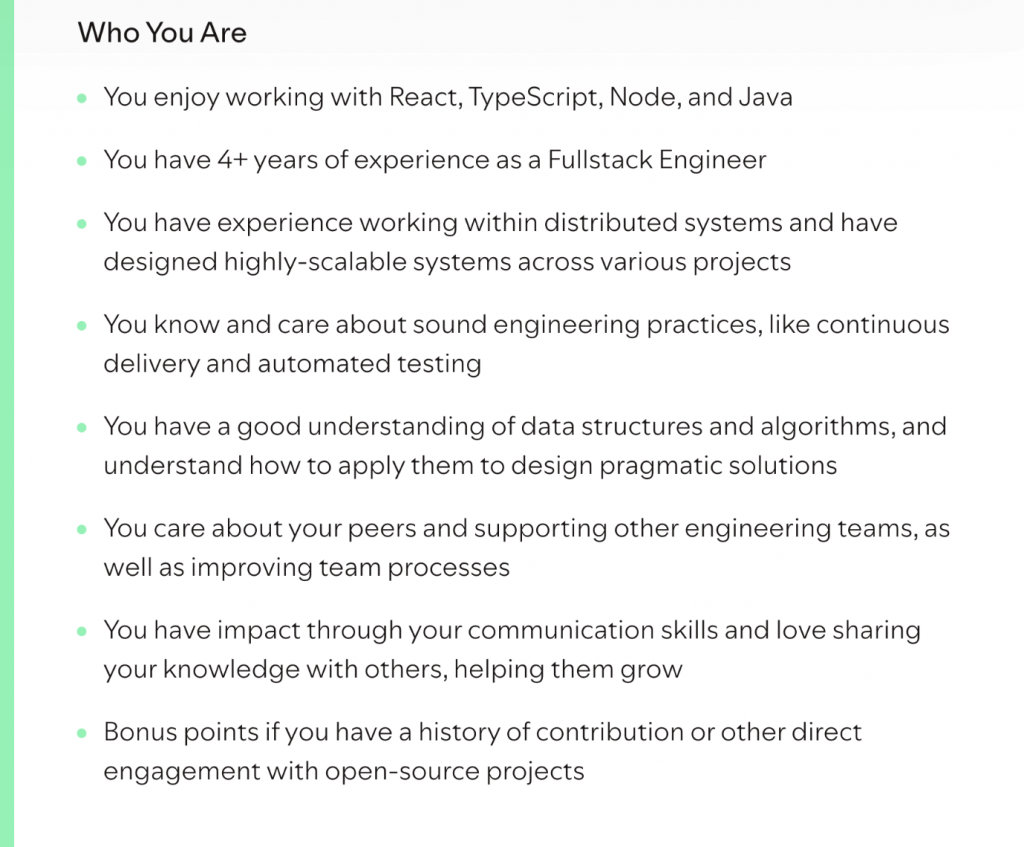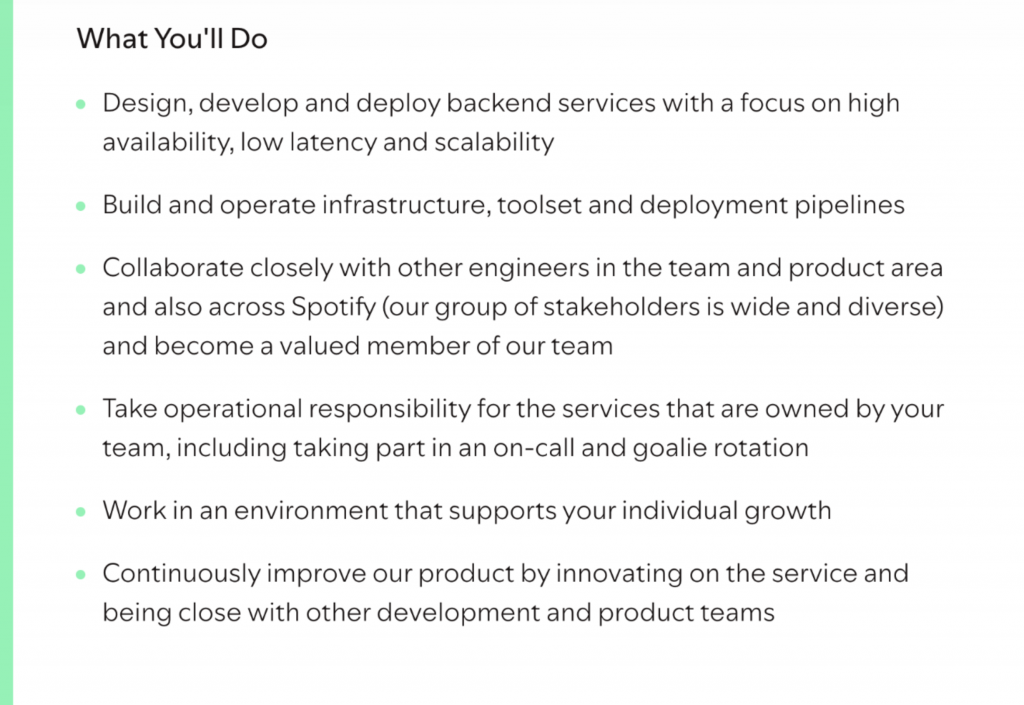Have you been struggling to create a job advertisement that attracts top developer talent? You’re not alone. Crafting a standout job post can feel challenging, but with the right approach, it’s a skill you can master. Follow these nine straightforward steps to create a compelling job ad that resonates with the right candidates.
1. Start with a clear and specific job title
As a rule of thumb, you should approach crafting your job description the same way you would craft your resume: placing the crucial information upfront. Keep in mind that you are competing with hundreds of other job ads, and you don’t want to risk your ideal candidate scrolling past yours. Therefore, it’s essential to capture your audience’s attention by presenting key details as soon as possible. Similarly, you can approach this like a journalist, seeing your job title as the headline that captures attention and encourages the audience to keep reading.
The job title is the first thing potential candidates see, so keep it straightforward and informative. Avoid confusing, overly creative phrasing like “Rockstar Developer.” Instead, include key details such as seniority level and type of engineer (full-stack, front-end, back-end) to set clear expectations.
Depending on the character limit for the job title, you may also want to include:
- the work setting (in-office, hybrid, or remote; if remote, you may specify the country or region where remote work is allowed)
- selling points (like “SaaS platform,” “high traffic app,” “AI features”)
- specific frameworks (like Angular, Laravel, Spring Boot, etc.).
Here are a couple of examples of how you can structure your title:
- Senior .NET Developer (Fully remote – UK only)
- Senior Full-Stack Software Engineer, Node.js/ Angular

2. Keep dropping all the key information
Most job portals offer dedicated fields for displaying key information directly below the job title. Utilize these features to enhance clarity and make essential details immediately visible. For example, the screenshot below from the Jobshark website showcases critical information such as the company name, job location, employment type, and work setting.

Now, use your opening paragraph to give candidates a snapshot of the position right away. You can quickly describe the project and explain how the developer would contribute to it. If not already mentioned in separate fields, details such as position type (full-time or part-time) and employment type can be included here. If the role offers a relocation package, highlight that as well.
When deciding whether to disclose salary information in your job ad, consider country-specific practices and regulations. And while there’s no universal approach here, one thing is for sure: talented developers are usually spoilt for choice — in fact, there might even be developers whose services you cannot afford. To save time for everyone involved (including yourself) and weed out developers with incompatible salary expectations, it’s best to be as transparent as possible as early as possible.
Looking ahead, salary transparency will soon be a legal requirement in the European Union. By June 2026, the pay transparency directive will mandate that employers disclose starting salaries or salary ranges either in job ads or early in the hiring process, before the interview.
So, if you decide not to include a salary range in your job posting, make it a priority to discuss compensation early in the process, ideally before the interview stage. Partnering with a tech recruiting company like Jobshark can make this process seamless. Jobshark discusses compensation with candidates individually early on to align salary expectations, saving time for both parties and fostering trust. This approach is particularly convenient if you’re open to hiring candidates with varying experience levels: it allows you to provide a more accurate figure based on each candidate’s specific experience, unlike the broad ranges typically included in job ads.
By prioritizing transparency and open communication, you’ll strengthen your reputation as an employer of choice in a competitive talent market.
3. Write a concise and appealing “About us”
Unless you’re hiring for a FAANG company, Microsoft, or another tech giant, don’t assume that candidates are already familiar with your organization. Include a concise paragraph in your job ad with essential facts about your company — such as its mission, size, and products.
While strong candidates will likely do their own research if interested, it’s your job ad that needs to spark that initial interest.
4. Specify required experience and skills
Now that you’ve got their attention, you can proceed to share the skills and experience you’re looking for.
First, be realistic. Avoid listing every skill under the sun because that candidate doesn’t exist. Doing so could harm your employer brand — be careful not to end up on a list of bad job ads.
Second, hire for adaptability. A developer who ticks every box on an overly specific list of requirements isn’t necessarily the most talented, motivated, or suitable for the long term. That’s because, while essential skills are important, adaptability is just as critical in the fast-paced, ever-evolving world of software development.
Take two candidates: one who meets all your current requirements but isn’t so adaptable or motivated, and another who doesn’t meet every criterion but is a quick learner with a strong drive to improve. Over time, as your business and its projects evolve, the adaptable developer is more likely to thrive.
In other words, a developer who checks all the boxes today might seem ideal, but in two years, those requirements are likely to shift. If they lack adaptability, then they may not be the best choice for the long term. If you have to choose, hire for adaptability to ensure you’re building a team ready to grow with your company rather than one that might become outdated as your needs change.
Third, clearly differentiate between must-have and nice-to-have requirements. Mixing the two can inadvertently discourage qualified candidates who may feel inadequate based on non-essential criteria, ultimately narrowing your talent pool.
Likewise, refrain from omitting nice-to-have requirements altogether. Even if unstated, these preferences exist and influence your evaluation process. By communicating them openly, you allow candidates to better tailor their applications, increasing their ability to present themselves as strong contenders and making your job easier. It’s a win-win for everyone.
As an example, here is an excerpt from a job description for a Full-Stack Engineer position at Spotify:

Spotify’s job ad outlines the broader skills relevant to the position, like experience with highly-scalable distributed systems, general deployment and testing practices, and important soft skills. It also clearly states the nice-to-have requirement, highlighted as “bonus points if you have…” It’s an ad that does a good job of listing requirements in a way that attracts candidates rather than discouraging them.
5. Clearly define responsibilities
Inform developers about the projects they can assist your company with. This is where you set the right expectations, so don’t oversell because it could easily backfire. Instead, give candidates a clear picture of the day-to-day tasks and overall scope of the role. Include details about the tech stack, project management methodologies, and collaborative opportunities.
Here’s another good example from Spotify. They were looking for a Junior Back-End Engineer:

6. Showcase your workplace and benefits
Highlight what sets your workplace apart by emphasizing your employee value proposition (EVP) — the unique qualities that make your organization a great place to work. This could include career development opportunities, flexible work arrangements, a strong emphasis on work-life balance, or a supportive and inclusive company culture. By highlighting what’s special about your organization, you increase your chances of finding compatible hires who are more likely to thrive and stay with your organization.
Complement this section by sharing details about your compensation package, benefits, and perks to give potential candidates a clear picture of the value they’ll gain by joining your team. This is the moment to talk about salary ranges, bonuses (such as sign-on, performance, or referral bonuses), paid time off (PTO) policy, and benefits like additional parental leave, medical and dental insurance, gym membership, company retreats, discounts on company products or services, or paid sabbatical leave. Developers, in particular, often prioritize opportunities for learning and career growth, so be sure to mention any training programs, mentoring opportunities, or subsidized courses.
If your work setting is hybrid, specify expectations, such as the number of in-office days or flexibility around scheduling. Additionally, clarify whether visa sponsorship is available, as this can either broaden your candidate pool (if you can sponsor visas) or save everyone’s time (if you can’t).
To further showcase your workplace culture and values, consider linking to videos, testimonials, or other engaging materials. These resources provide candidates with an authentic glimpse into what makes your organization unique and can help them envision themselves as part of your team.

7. Add a call-to-action
Conclude your job ad with clear instructions on how to apply. Include links to your application portal or an email address for submissions.
Many platforms, including LinkedIn, provide an interactive button that directs candidates to the application form. However, users often share or replicate the listings elsewhere, sometimes via screenshots or copy-pasting. To ensure candidates can reach you even when the interactive buttons are unavailable, it’s a good idea to include either the application link or an email address in the body text. Since most companies use an Applicant Tracking System (ATS) — a software tool that streamlines and automates the recruitment process — it’s better to provide a link that directs candidates to apply through the system.
If you don’t have an ATS, you can opt to include an email address instead. Alternatively, consider partnering with a tech recruiting company like Jobshark, which offers an ATS to optimize the hiring workflow, or other SaaS platforms like BambooHR or Teamtailor. An ATS uses filters to identify the most suitable candidates based on keywords, qualifications, or experience, reducing bias and human error. This system centralizes all candidate information in one database, making it easy to monitor their progress through the hiring pipeline. It also allows team members to collaborate seamlessly by sharing notes and feedback within the platform.
Additionally, an ATS helps organizations maintain compliance with labor laws and data protection regulations by securely storing candidate information. Overall, it not only simplifies the recruitment process but also improves candidate experience, helping organizations secure top talent efficiently.
Finally, to complete the first draft of your ad, set expectations about the timeline and steps in the hiring process. It’s advisable not to mention a deadline for applications, as deadlines can have the surprising effect of discouraging candidates from applying promptly — they might instead find other opportunities in the meantime. A more effective approach is to continuously assess incoming applications.
Here’s an example of how to establish clear expectations about the timeline and steps:
Ready to join our team? Send your resume and portfolio to [email address] or apply online at [URL]. We’ll review applications on a rolling basis and reach out to qualified candidates within one week.
Our hiring process consists of three stages:
1. Initial call
2. In-depth interview
3. Skill test.
8. Use inclusive language throughout your advert
Opt for gender-neutral terms like “they/them” and avoid language that may inadvertently discourage women and non-binary candidates from applying. If you’re unsure about your phrasing, tools like Gender Decoder can help identify bias in job ads.
Be cautious about imposing unnecessary qualifications, such as requiring a “degree from a top-tier university,” which could deter otherwise qualified candidates. And beyond the discussion about what’s unanimously a top-tier university, it’s important to question the very necessity of setting formal education as a non-negotiable for developers. While a degree may be relevant when hiring junior developers without experience, insisting on one for senior roles can exclude talented candidates who have acquired their skills through boot camps, online courses, or self-directed learning.
Similarly, reconsider requirements like “excellent communication skills” or “strong teamwork abilities” for roles where these traits are not critical, as they might discourage neurodivergent candidates. For instance, strong interpersonal skills are not a must-have for a data-focused position. Stick to what’s essential for the role to ensure inclusivity and attract a wider talent pool.
9. Review and optimize for readability and SEO
To err is human; to spell-check, divine. Fortunately, several tools can help you revise your text, such as ChatGPT, Grammarly, or the Google Docs spellchecker. In fact, AI can be used throughout the writing process to provide feedback on the tone, structure, and other aspects — LinkedIn even offers its own AI assistant for job ads.
Ensure your job ad is easy to read by highlighting important information in bold, using short paragraphs, bullet points, and clear headings. Keep a friendly, welcoming tone throughout the ad.
Additionally, incorporate relevant keywords (e.g., “Java Developer,” “remote-friendly tech jobs”) through the body text to improve visibility on job boards and search engines. If you’re posting the job ad on your own website, use structured data to help search engines better understand and display the job posting, also making it eligible for rich search features, such as enhanced visibility on Google Jobs. If you’re using reputable job portals, they should already be utilizing structured data to optimize job postings.
Wrapping up
Take the job ad as an opportunity to streamline your hiring process, weeding out unsuitable candidates and enticing the appropriate ones. Rather than just providing a list of all the things you want, highlight what you have to offer.
Remember to be clear, concise, and inclusive. Your job ad should strike a balance: detailed enough to clearly convey the key aspects of the opportunity and engage your target audience, yet concise enough to maintain their interest and avoid overwhelming them.
If you’re looking to boost the visibility and effectiveness of your job advertisement, partnering with a tech recruiting company can be an excellent solution. Their experienced recruiters not only help craft compelling ads tailored to your target audience but also ensure they’re promoted across the most effective channels. Moreover, they can handle early-stage salary discussions with candidates individually, ensuring that expectations are aligned from the start.
In addition, these professionals can manage the entire recruitment process, saving you time and resources. This includes headhunting, social recruiting, screening and testing candidates, arranging and conducting interviews, and reference and background checks. The right partner ensures your hiring process is both professional and swift, minimizing the risk of losing strong candidates due to delays or unnecessary steps. Jobshark provides the flexibility to choose from all these services while throwing in free job ads for good measure.
Subscribe to our newsletter
Love what you’ve just read? Subscribe to the TechTalents Insights newsletter and receive our best articles and interviews directly in your inbox. Click here to join the community!




